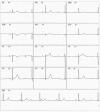Conduction Disorders: The Value of Surface ECG
- PMID: 32392118
- PMCID: PMC8226204
- DOI: 10.2174/1573403X16666200511090151
Conduction Disorders: The Value of Surface ECG
Abstract
Purpose of review: The purpose of the current mini-review is to describe the importance of surface ECG for the diagnosis of conduction disorder.
Methods: The MEDLINE/PubMed database was used, with the keywords "ECG" and "conduction disorders"; over the past 10 years. Other documents were included because of their relevance.
Main findings: Data on the anatomy and function of the cardiac electrical system have been described. Conduction disorders including sinus node dysfunction, atrioventricular blocks, intraventricular conduction disorders are exposed as to their epidemiology, etiology, presentation, anatomical site of impaired conduction of the electrical stimulus. The importance of ECG in patients with a cardiac implantable electronic device was also discussed, in addition to future perspectives.
Conclusion: Surface ECG allows the diagnosis of atrioventricular and intraventricular conduction disorder and its anatomical block site most of the time, without the need for invasive tests such as electrophysiological study. Dysfunctions of cardiac implantable electronic devices can be diagnosed by ECG, as well as the prediction of response to cardiac resynchronization therapy.
Keywords: Cardiac conduction system diseases; bundle-branch block; cardiac resynchronization therapy.; electrocardiography; heart conduction system; sinus node dysfunction.
Copyright© Bentham Science Publishers; For any queries, please email at epub@benthamscience.net.
Figures








References
Publication types
MeSH terms
LinkOut - more resources
Full Text Sources
Other Literature Sources
Research Materials
Miscellaneous

